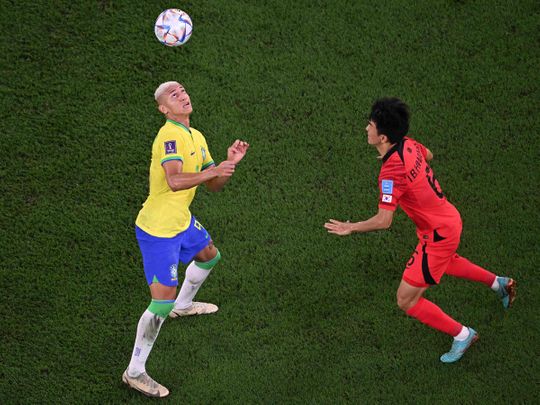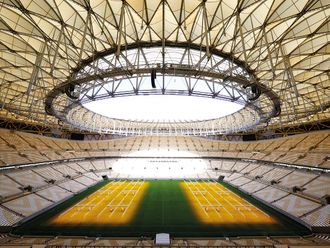
We are here. We are here to win the Qatar World Cup. That’s what Brazil said on Monday night. The 4-1 win over South Korea has been a massive statement. A warning to rivals. A fearsome display of attacking prowess. Each of the goals felt like stiletto slashes as the Latin Americans glided around the Stadium 974 pitch like ballerinas.
It was football ballet in Doha. Vinicius Junior, Raphinha, Richarlison, Lucas Pasquet, Casemiro and Neymar Junior tip-toed into the South Korean penalty box repeatedly with ease and elan. They twisted, turned, leaped and pirouetted before the slipping the ball into the net. More dancing followed.
Each goal was celebrated with a circular bouncing dance near the corner flag. Pasquet did a solo dance before his teammates converged on him. Richarlison ran to the substitutes’ bench to celebrate his goal with coach Tite, who too shook a leg. It was dance on football field. A Brazilian dance. The Samba dance.
How Brazil danced the night away
A dance that silenced their critics. Brazil needed it. Brazilian fans need it. The sea of yellow-clad supporters at Qatar’s stadiums had been disappointed with the underwhelming performance in the group stage. After a clinical display to subdue Serbia, Brazil struggled to overcome Switzerland and lost to Cameroon (Nine changes is not an excuse for this star-studded team).
What changed? The difference was Neymar. He was at the heart of Brazilian attacks that took down the stubborn Serbians with a three-goal burst. Injury kept the Paris Saint-Germain forward out of the next of two games, where Brazil worked hard with meagre rewards.
Neymar undoubtedly is Brazil’s talisman. His return galvanised the frontline which waltzed and wove to score four in 40 minutes. Brazil were wasteful too: Richarlison and Pasqueta could have added more and doubled the score. Yet their supporters wouldn’t complain, although Brazil seemed to ease off in the second half.
The first 45 minutes was pure football heaven. A Samba show. With swift passes, the ball was caressed upfield through twinkle feet, slicing through the South Korean defence with deft touches before side-footing into the net. Even Neymar’s penalty was effortless. Only Pasqueta’s strike had some power.
The Richarlison masterpiece
Richarlison’s gorgeous goal, the third of the night, encapsulated the Samba symphony. Twenty-eight minutes into the match, the Brazilian striker juggled the ball with his forehead despite pressure from South Korean midfielder Hwang In-beom at the top of the box. He headed it lightly three times before dropping the ball to his feet and passing it to Marquinhos, who had his back to the goal. The defender played a square pass to Thiago Silva in front and the centre back’s through ball found Richarlison, who slipped it in the net.
It was a goal that left me gasping for breath. A goal so brilliant in conception and execution, it could rank as the goal of the tournament. But then Richarlison had another contender as well: his outrageous acrobatic goal against Serbia.
What's Brazilian football artistry?
It was magic. All silken touches. Unhurried, smooth and effective. Charming and seductive. It was the football the world loves. The football that brought Brazil legion of admirers worldwide. It was football from another planet. It was Brazilian football from another era.
The last time I saw these moves was in 1982, when Socrates, Zico and their merry band drew arcs and angles in Spain before Italy’s Paolo Rossi ruined it in the quarterfinal. The last time Brazilian artistry won was in 1970, when Pele orchestrated the triumph in Mexico which allowed Brazil to keep the Jules Rimet Trophy.
Brazil’s wins without flair
Brazil won the new FIFA World Cup twice, but not with the same mesmeric brand of football. Coaches ditched the Brazilian magic for European efficiency. Carlos Alberto Pariera’s team was effective enough to win USA ’94 on penalties in the final against Italy, but Romario, Bebeto and the rest lacked the Samba flair. Luiz Felipe Scolari opted for a pragmatic approach when Ronaldo and Rivaldo won it for Brazil in 2002.
Tite brought back the Samba style as Brazil chase a sixth trophy in Qatar. And he has a bunch of magicians who conjure goals out of thin air with a wave of their feet. The win over South Korea was Brazilian football at its best: poetry in football. Even Pele would have approved. It was only fitting that Neymar brought a banner to honour a stricken Pele, who lies in a hospital bed in Sao Paolo.
The poem was an ode to Pele.




